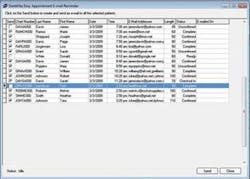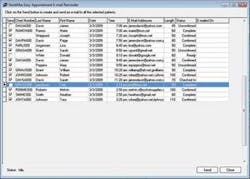Take control of your financials
by Dr. Joe Blaes, Editor
For more on this topic, go to www.dentaleconomics.com and search using the following key words: financials, recall systems, economic times, financial goals, collections, Dr. Joe Blaes.
As I read the morning paper, my eyes were drawn to the headline “NO ANSWER FOR STOCK FREEFALL!” The article went on to report that the Dow Jones Industrial had plunged below 7,000 to a level not seen since 1997. Clearly, from Wall Street to Main Street, we are in troubling times; and, unfortunately, our corner of the health-care market is not immune to the effects of this economy. From patients reluctant to accept treatment plans to recently laid-off patients not keeping their appointments, we are being affected. So, what is the economic situation of your practice? And, more importantly, what are you doing about it?
Take control
Yes, as the owner of a dental practice, there are many things that you control and should do to enhance your practice's financial performance, even during an economic meltdown. Understanding what these things are and implementing them in your practice will determine how well you weather this economic storm.
To increase your practice's financial performance, you'll want to address three financial questions:
- Are my collections where they need to be?
- Am I effectively minimizing missed appointments?
- Do I set and track my financial goals?
Maximize your collections
A number of years ago, one of my colleagues became increasingly frustrated with his practice's financial performance. He complained that no matter how many additional crowns he cut or veneers he cemented, his cash flow remained stagnant. Curiously, his increased efforts didn't seem to have any effect on his practice's overall financial performance.
So he did what many of us have done — he opened his practice to a consultant. After just a few hours, the consultant found a glaring problem — his collections were at a pathetic 79%.
When times get tough, undercollecting or simply not collecting your hard-earned money is a mistake that you cannot afford to make. Phasing treatment plans or offering a reduced level of care because of your perceptions of the patients' ability to pay should also be minimized as these directly affect production and cash flow.
Most likely, you have paid for computer software that is specifically designed to help you monitor your collections. Software like Dentrix, DentiMax, EagleSoft, and SoftDent include great collection features. Many popular software programs also have patient financing applications built right into the program so you can submit pre-populated applications from the patient's screen and receive an instant credit decision.
Needless to say, patient financing eliminates the collections issue altogether. If you have not been using your software's financial tools, now is the time to start. Familiarize yourself with your patient aging reports and insurance aging reports. With the proper aging reports, you will be able to identify problems with your practice's collections.
Once you've identified your collection problems, you'll want to put your staff to work. In your next morning huddle, use a highlighter to identify large outstanding patient and insurance balances. Then direct your front desk to call these patients and insurance companies. Your staff may need to resubmit claims, and even send patients to collection agencies.
Use an effective appointment reminder and recall system
A good patient reminder and recall system is the lifeblood of most successful practices. Fortunately, just like your patient collection needs, your computer software system should provide an effective system to help your staff ensure high patient appointment compliance.
Recall appointments — I find that the best time to create recall appointments for patients is while they are still in the office. Be sure your staff does everything they can to make your patients' next check-up appointments before the patients leave.
Sure, patients might forget the exact day of an appointment six months out, but the mere fact that they have made an appointment will serve to commit them to coming back. Your software should provide an easy way to print recall appointment cards and lists so that, well before the scheduled appointment, you can remind patients.
Appointment reminders — There is nothing quite like experiencing a no-show on a three-unit bridge appointment. We've all had them, and to some degree, it goes with the territory, but there are new tools available that will help minimize missed appointments. To be sure, your front desk staff should make personal confirmation calls to all large cases; however, this type of personal follow-up drains a staff's time and may be overkill for smaller cases, especially for offices running on a lean staff. Some software systems now offer the ability to e-mail customized appointment reminders directly from the appointment book screen.
If your system doesn't have this capability, you may want to look into a third-party add-on service that can send e-mail and/or text message reminders to patients. Don't overlook your appointment reminder system because anything you can do to help your patients keep their appointments will have a direct impact on your bottom line.
Financial goals
It has been said that those who fail to plan, plan to fail. It is so easy for dental practices to get stuck in the same old routines, experiencing the same old financial results. Don't be this practice. Set specific, measurable financial goals for your practice and communicate these goals to your staff.
Several years ago while attending the Anaheim CDA Exposition, I reviewed software that graphically displayed the following three major cash-flow indicators:
- The true dollar figure for future appointments
- The dollar figure for completed work
- The amount of actual cash the practice has collected
These are the cash flow figures you need to manage your practice. May I make a suggestion? Set financial goals for each one of them and then check daily to compare your actual results to your set goals. Then, as needed, make the necessary adjustments and corrections to your practice. This approach will help you know exactly what changes you need to make.
Each week you will be able to measure how your actions directly impact your financial results. Whether it is changes you made in your collections process or to your appointment reminder process, you will see how these changes impact you financially.
Summary
During an economic downturn, you need to be actively engaged in assuring the financial success of your practice. From ensuring your collections are where they need to be, to minimizing missed appointments, to making specific measurable goals, you can be in control of your financial performance. And, with the right reports and software tools, you and your staff will make certain that your practice not only survives but thrives during these troubling economic times.


